The Silk Painter’s Path: Exploring Asia’s Rich Tapestry of Textile Art
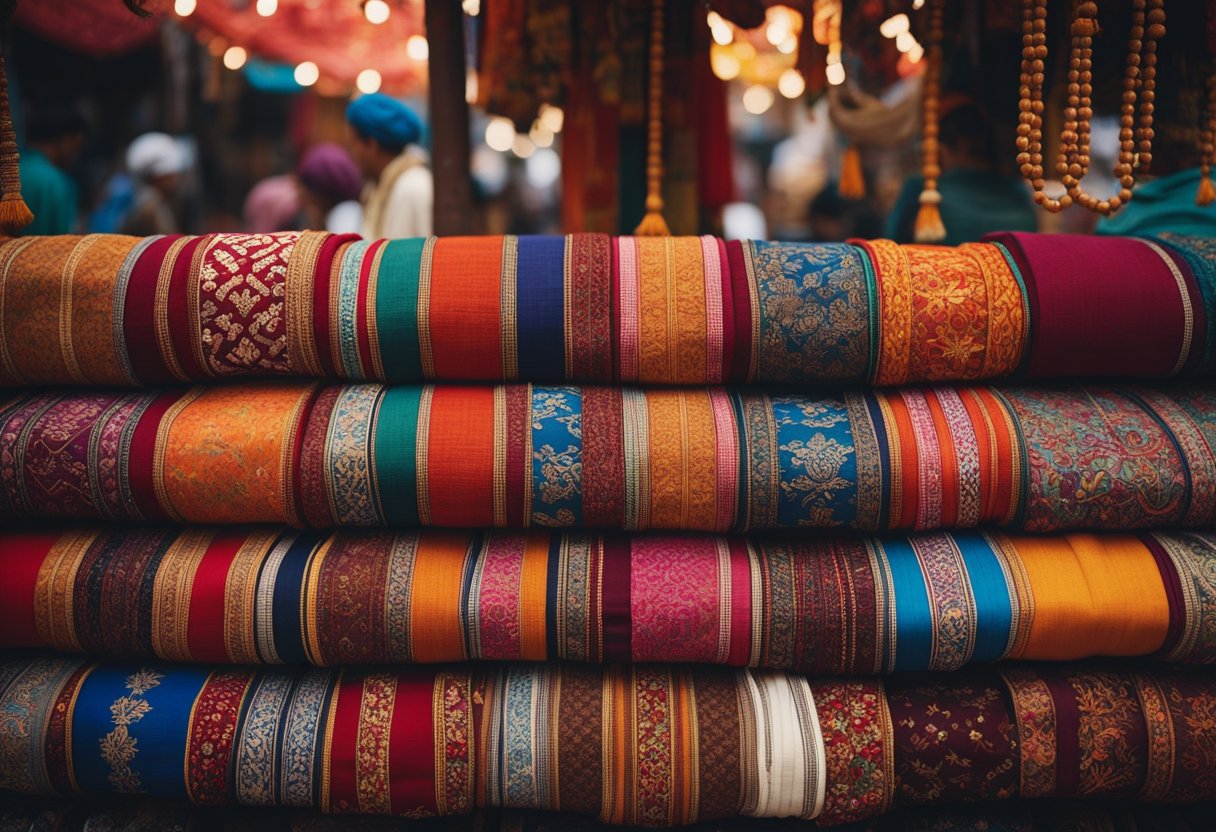
Updated On: April 22, 2024 by Eman Sameh
Embarking on the silk painter’s path is to traverse the storied landscapes of Asia’s rich textile heritage. Silk, a hallmark of luxury and elegance, has shaped the social and economic fabric of Asia for centuries. The Silk Road—a historical network of trade routes bridging East and West—was the cradle of countless cultural exchanges, from the whispers of ancient towns and bustling cities to the silent looms weaving masterpieces in secret chambers. This arterial passage not only facilitated the exchange of goods like gold, tea, and spices, but it was also a conduit for disseminating art, religion, and ideas.
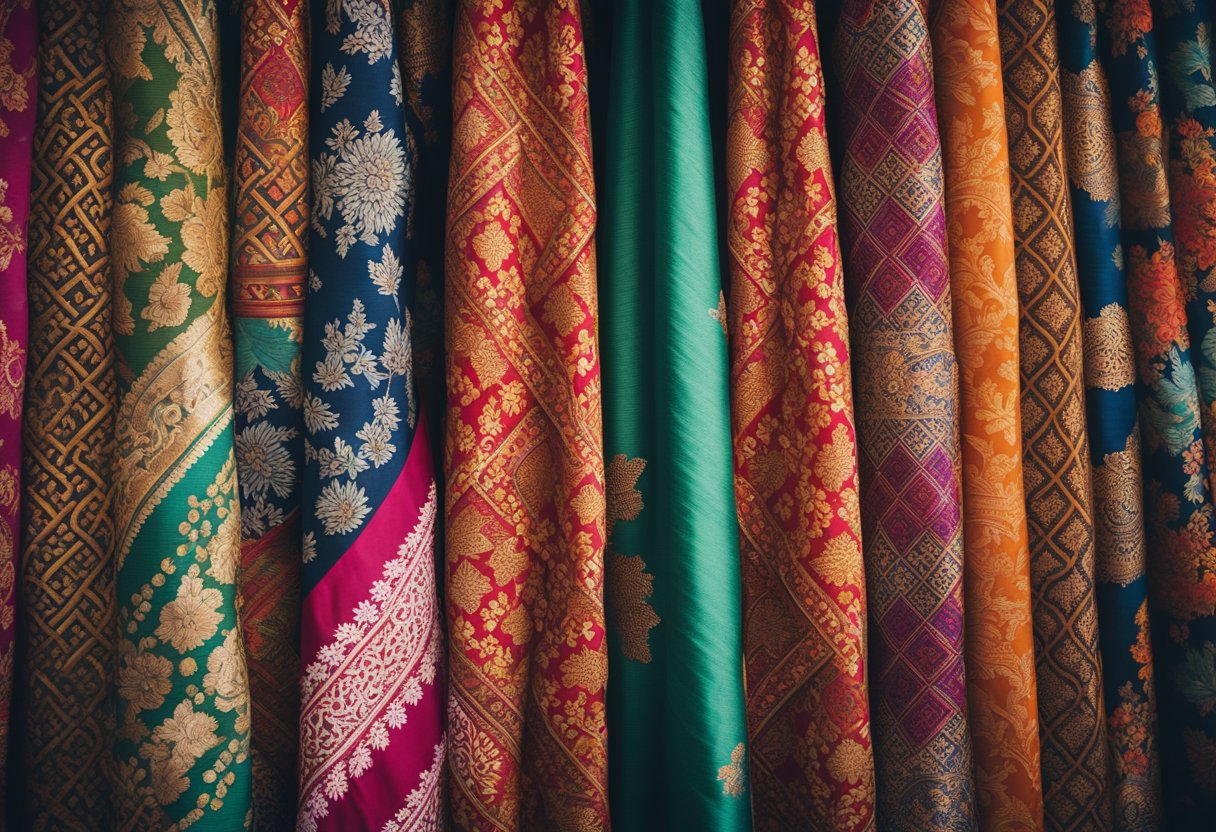
The evolution of silk painting reflects the intersection of religious influence and regional culture, where every brushstroke captures the beliefs and stories of its time. From the lofty heights of the Middle East to the shores of the Mediterranean Sea, silk paintings have witnessed the rise and fall of empires, the spread of religions like Buddhism and Christianity, and the endless thirst for beauty that transcends temporal bounds. Asian textile art has been deeply intertwined with societal values, revealing the spiritual narrative that textiles carry within their fibres.
Our exploration of this heritage uncovers these artistic endeavours’ profound impact on modern-day cultures and economies. Preserving this living history ensures the endurance of these traditions whilst contemporary artisans blend ancient techniques with new inspirations, securing a place for Asian textile art in a global tapestry.
The Silk Painter’s Path History
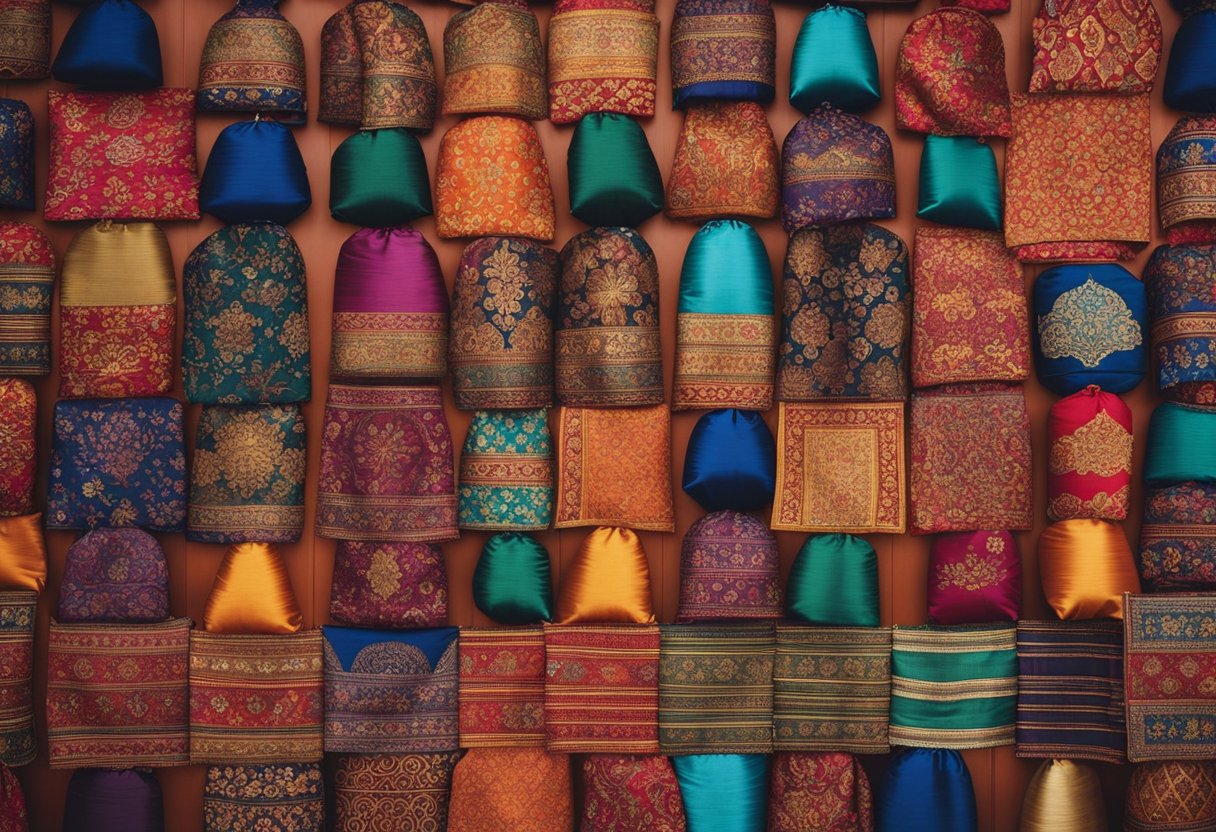
The Silk Road is a monumental network in our world’s history, profoundly impacting trade, cultures, and knowledge exchange across vast regions. Let’s explore the key aspects of this historical phenomenon.
Emergence and Evolution
Emergence: Our journey begins with the Han Dynasty formalising this network for trade and diplomatic missions, notably through the endeavours of Zhang Qian. His travels underline the beginnings of what would eventually be known as the Silk Road.
Evolution: Over time, the Silk Road expanded, morphing into a complex system of routes encompassing the ancient world. These routes facilitated not just trade but also the transmission of ideas, fostering relationships between the Middle East, the Roman Empire and beyond.
Cultural and Economic Impact
Cultural Exchange: Along this network, Buddhism, Islam, and Christianity spread their influence, entwined with local beliefs. Ideas were as pivotal as goods, travelling from East to West and back again, contributing richly to our global heritage.
Economic Flux: Far more than silk traversed these routes. Camels laden with gunpowder, precious metals, and, tragically, diseases like the Black Death also journeyed across continents, marking profound economic swings between civilisations.
Major Figures and Expeditions
Pioneering Explorers: The esteemed traveller Marco Polo is a name synonymous with the Silk Road, whose journeys illuminated the richness of Asian cultures to the Western world. Similarly, Ferdinand von Richthofen provided the West with the term “Silk Road”, highlighting its historical geography.
Influential Conquerors: The fearless Mongols, under figures like Genghis Khan, harnessed the Silk Road’s network, not for trade but for conquest, weaving a narrative of war into the fabric of its history. These figures and events are etched firmly into the legacy of the Silk Road.
Geography and the Main Trade Routes

The Silk Road was not a single thoroughfare but an interlacing network of trade routes that connected the East with the West. It spanned across several landscapes and cultures, facilitating the exchange of goods, concepts, and artistry, particularly the textile trade. Central Asian corridors were pivotal in this intricate network, with vital branches stretching out to various continents.
Central Asian Corridors
The Central Asian corridors of the Silk Road were pivotal, traversing through what are now Uzbekistan, Kazakhstan, Kyrgyzstan, and Tajikistan. These passages functioned as the heart of Silk Road commerce, facilitating exchanges between China and the Mediterranean. Cities like Samarkand in Uzbekistan became crucial hubs, where the narrow trails of the rocky Pamir Mountains met the vast expanses of the Gobi Desert. Silk and spices from China, gold and silver from Europe, and myriad other goods converged on these routes, weaving a tapestry of interconnected economies and cultures.
Branches Across Continents
The Silk Road’s branches across continents extended the influence of Asia’s textile art to India, Rome, and the expanse of Europe. Under the Han Dynasty, China’s silk weavers found a lucrative market in Rome, with European tastes fuelling the demand for fine textiles. These diverging paths crossed challenging terrains, linking the steppes of Central Asia with the dense forests and great cities of Europe, while maritime routes connected ports along the Mediterranean Sea. The exchange along these routes went beyond goods; they were also the conduits for ideas, cultures, and innovations.
Silk Production and Trade

Focusing on silk production and trade highlights the ancient craft and commerce that stretched across continents, connecting cultures and economies through the luxurious textile known as silk. Originating from China, the ways in which silk was cultivated and then traded along the Silk Routes have left a lasting impact on textile art and trade throughout history.
Silk Cultivation
Silk cultivation, or sericulture, involves a meticulous process that starts with the rearing of silkworms on mulberry leaves. Upon maturing, these silkworms spin cocoons, which are then boiled or steamed to unravel the silk filaments. China’s expertise in sericulture gave rise to high-quality Chinese silk, a sought-after commodity that fuelled not only local textile artistry but also international demand and trade.
Silk as a Commodity
Once produced, silk became a principal good for exchange along the vast trade routes known collectively as the Silk Routes. This network connected China to the Mediterranean, facilitating cultural and commercial exchange between civilisations. Chinese silk travelled these routes, influencing textile techniques across Asia and Europe. The trade of silk and other goods fostered profound connections and economic growth among diverse empires and cultures along these paths.
Textile Art Across Asia
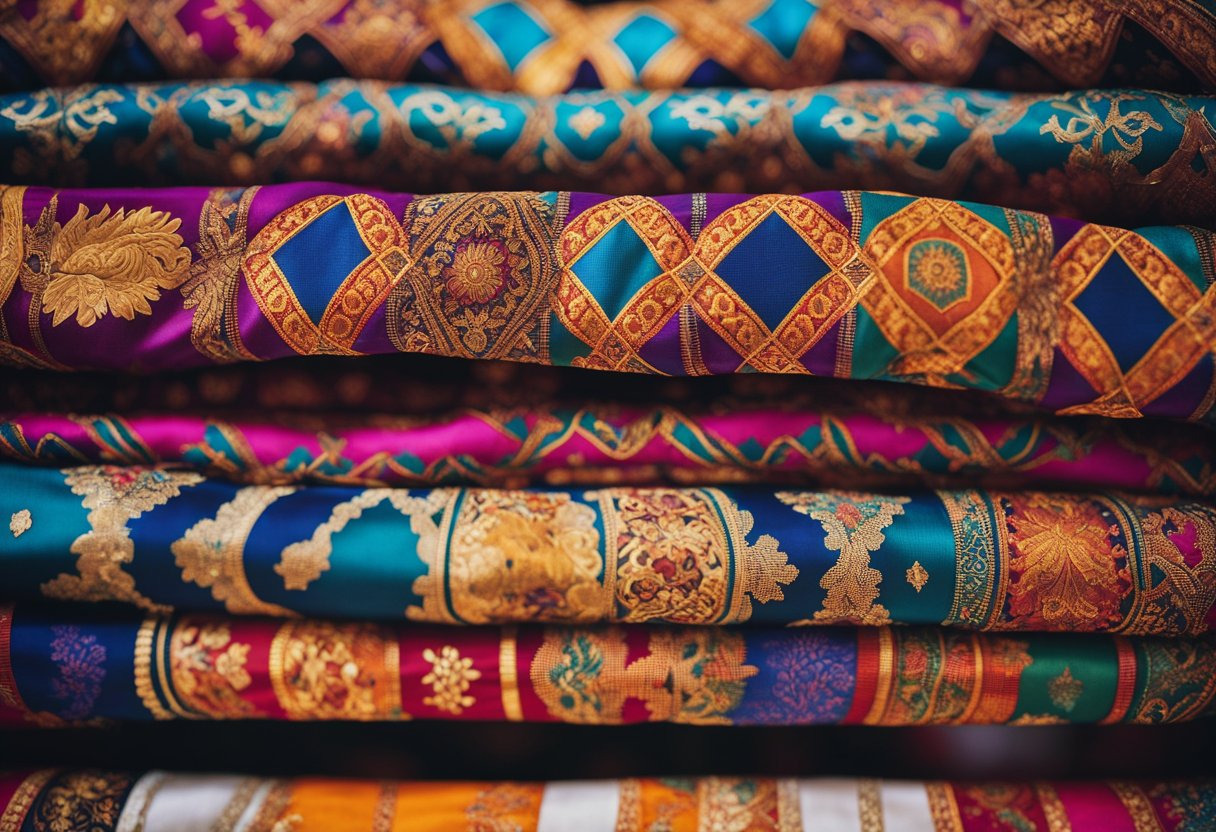
Textile art holds a distinguished place in the intricate tapestry of Asian arts and culture, celebrated for its diverse techniques and rich visual language.
Local Techniques
We find that various regions across Asia have cultivated unique textile art forms that are deeply intertwined with their cultural traditions. For instance, China is renowned for its silkworm silk production, a technique that dates back to the fourth millennium BCE. Conversely, India is celebrated for its vibrant cotton and silk weaving, producing iconic textiles such as the Banarasi silk and the vibrant Rajasthan cotton. These local techniques are not only a reflection of artistic expertise but also a testament to the ingenuity and creativity of Asian artisans.
Artisan Communities
For centuries, artisan communities across Asia have been interconnected through the exchange on ancient trade routes such as the Silk Road. These connections have led to a proliferation of shared knowledge and hybrid styles, evident in creations like Central Asian rugs and carpets. These communities preserve the mastery of textile weaving and dyeing methods, ensuring the longevity of traditional practices in an age dominated by industrial production.
Visual Language of Textiles
The visual language of textiles in Asia is an eloquent narrative of both the every day and the divine. From the dragon motifs in Chinese silk to Islamic geometric patterns in Persian carpets, textile art is imbued with symbolism. This language transcends barriers, with motifs and techniques spreading through regions and influencing the visual culture from Central Asian caves to South Italian churches, highlighting a rich, interconnected heritage.
Influence of Religion and Culture on Textile Art
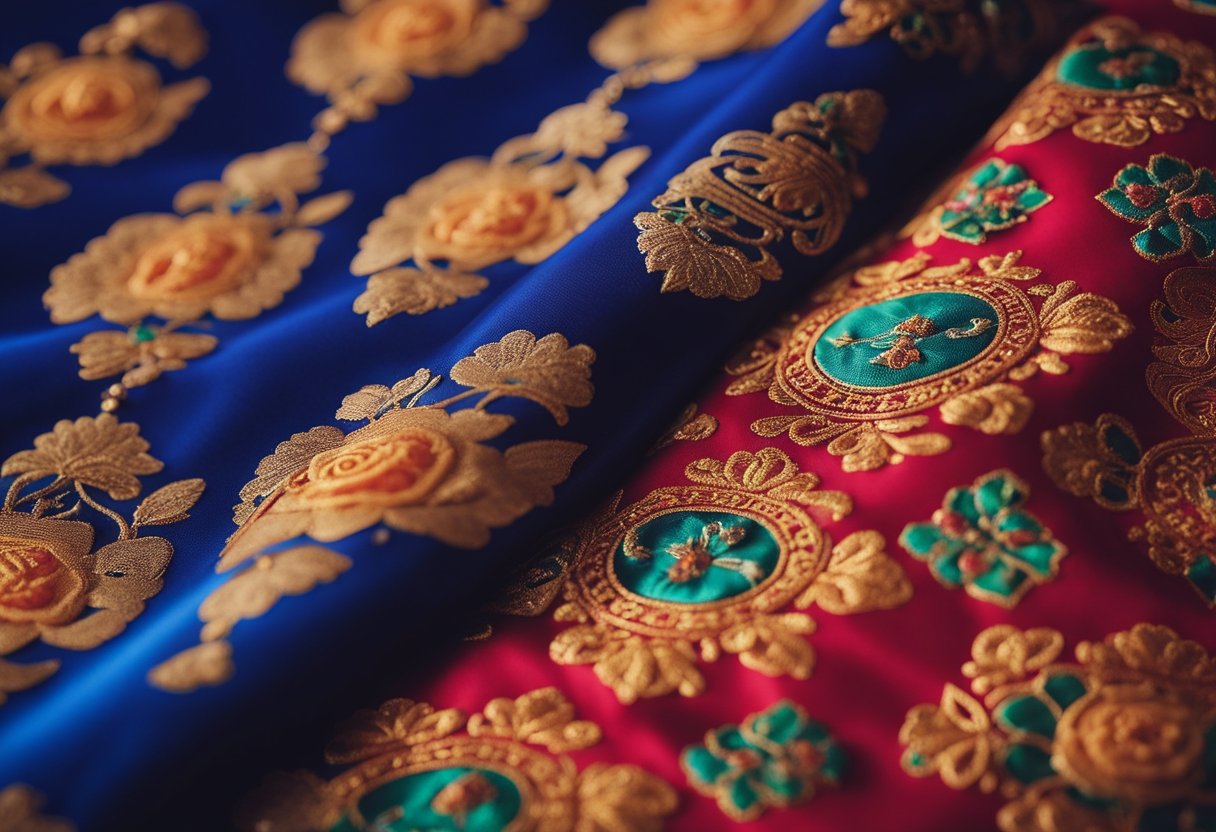
As we explore the intricate relationship between textiles and spirituality, we recognise that religious and cultural practices in Asia have significantly moulded textile arts. The visual magnificence of these textiles is not just a feast for the eyes but also narrates the intertwining of sacred traditions and cultural identity.
Buddhism and Islamic Motifs
Buddhism: Across Asia, Buddhist artistic traditions have greatly influenced textile designs. The religion’s symbols, such as the lotus flower and the endless knot, frequently embellish fabrics, symbolising purity and eternal harmony respectively. In the cultural landscapes of Tibet, monks’ robes and temple decorations exhibit vibrant colours and patterns that reflect Buddhist doctrine, with every hue and motif serving a deliberate spiritual function.
Islam: Similarly, Islamic art has left a profound imprint on textile arts, especially observable in mosques’ intricate tile work and architecture. Due to Islam’s aniconism, geometric patterns and arabesques, devoid of human and animal representations, are pivotal features. Textiles used within Islamic contexts often feature these complex designs, reiterating themes of unity and the infinite nature of creation.
Cultural Syncretism in Design
The cross-pollination of different Asian cultures and religions has spawned textiles rich with hybrid motifs. This syncretism is not merely aesthetic; it represents the pacific coexistence and mutual appreciation among diverse belief systems. For instance, on the historical Silk Road, the interplay between Buddhist iconography and Islamic geometry often emerged in textile patterns, revealing a dialogic relationship that transcended the borders of empires and steered cultural evolution.
Furthermore, in regions where trade and cultural exchange were particularly dynamic, textiles began to symbolise shared spiritual narratives and communal identity. This melting pot of influences underscores how deeply religion and culture are woven into the fabric of Asian arts, with each thread and dye whispering stories of devotion, tradition, and intercultural unity.
Key Cities Along the Silk Road

The Silk Road was a vital network of trade pathways that facilitated commercial and cultural exchange across Asia. Here, we focus on the key cities that not only enriched traders but also served as crucibles of culture and religion.
Economic Hubs
Samarkand and Bukhara, which are modern-day Uzbekistan, were pivotal cities along the Silk Road. Samarkand was renowned as a centre for exchanging gold and silver, while Bukhara served as a marketplace for precious stones and spices. Tashkent and Almaty also thrived as commercial hubs where caravans would stop to trade goods, some coming as far as the Mediterranean.
Cultural Centres
As for the cultural fabric, Khiva was instrumental in the proliferation of Islamic culture along the Silk Road. Through the movement of traders and scholars, cities like Samarkand and Bukhara became melting pots where religious beliefs and cultural traditions intersected. The fusion of different ways of life in these cities positioned them as key centres of knowledge and culture, influencing practices across Asia and beyond.
Major Commodities and Cultural Exchanges

Before embarking on the intricate pathways of textile art across Asia, we must understand the pivotal role of major commodities and cultural exchanges. These exchanges were the lifelines of development that permeated across continents.
Silk, Spices, and Precious Metals
Silk has long been a symbol of the opulent trade between cultures; its significance derived from not only its beauty but also its role as a commodity on the Silk Road. This luxurious fabric, once worth its weight in gold, facilitated a bustling trade that has shaped civilisations.
Spices, with their ability to preserve and flavour food, were as valuable as precious stones and often traded in volumes equal to their weight in silver. Goods such as cumin, cinnamon, cardamom, and pepper travelled from Asia to enrich international cuisines and heal with their medicinal properties.
Precious metals, including gold and silver, were not only used as currency but also exchanged for other commodities, pushing forward the economy and heralding the standard of wealth. Industries such as jewellery thrived with these exchanges, incorporating exotic designs influenced by cultural intermingling.
Ideas, Religion, and Technologies
Our engagement in exchanging ideas fostered an environment ripe for sharing knowledge across continents. Scholars, philosophers, writers, and artists traversed these trade networks, spreading enlightened thought and influential artistic techniques.
Religions, especially Buddhism and Islam, found new adherents and contributed to the rich cultural traditions as they expanded across trade routes. The influence of Buddhism can be seen in the serene expressions of the statues that adorned the ancient pathways.
Innovative technologies, such as paper, gunpowder, porcelain, and medicine, spread far and wide, triggering advances in science and daily life. Knowledge of gunpowder brought about the creation of guns, altering military strategies and the balance of power.
From the exchange of jade and precious stones to the diffusion of glassware and intricate porcelain, these commodities reveal the tapestry of cultural exchange that was woven through the bustling markets and expansive trade networks of historic Asia.
Impact of the Silk Road on Modern Trade

Reflecting on the Silk Road’s enduring influence, we observe how the ancient network laid the foundations for modern global trade and intercontinental relationships.
The Legacy of Intercontinental Commerce
The Silk Road’s legacy is evident in its profound impact on intercontinental commerce. It was more than just a trade route; it facilitated a remarkable exchange of goods, ideas, and cultures between Asia, the Middle East, and Europe. This network championed the very concept of long-distance trade, which continues to shape our economy today. UNESCO recognises several segments and sites of the Silk Roads as part of the World Heritage, underlining their historical significance and the enduring legacy. Appreciating how the Silk Road’s blueprint for exchange has informed contemporary trading practices is essential.
Silk Road in the Contemporary Economy
In the contemporary economy, the Silk Road has taken on new forms, with initiatives like the Belt and Road aiming to revitalise the ancient trade pathways. These modern trade routes seek to boost connectivity and partnerships between countries across Asia, extending to the Middle East, Europe, and beyond. The emphasis is on creating a seamless trade network, in a nod to the camels and caravans that once connected disparate regions through the Silk Road. By mobilising resources like tea, textiles, and technology, modern trade routes aim to echo the age of exploration spirit, strengthening ties between nations with roots in this historic pathway.
Conservation and Tourism

Responsible conservation and tourism are vital to preserving Asia’s Silk Road’s rich cultural tapestry and heritage. As we traverse this historic network, we must foster a balance between our eagerness to admire and our duty to protect.
UNESCO Heritage Sites
UNESCO recognises numerous locations along the Silk Road as World Heritage Sites for their outstanding value to humanity. The Silk Roads: the Routes Network of Chang’an-Tianshan Corridor is a prominent example. Encompassing an extensive network of trade routes, this corridor historically linked multiple civilizations and facilitated an exchange of goods and cultural philosophies across Asia.
Among such sites are the Registan and Shah-i-Zinda in Samarkand, Uzbekistan, which have marvellous architectural marvels steeped in history. The preservation efforts steered by UNESCO ensure the conservation of these sites while supporting sustainable tourism, allowing us to observe and appreciate these locations without forfeiting their integrity for future generations.
- Noteworthy UNESCO Silk Road Locations
- Bukhara, Uzbekistan: A hub of scholarly and architectural advancements.
- Samarkand, Uzbekistan: Encompassing significant monuments like Registan.
- Shah-i-Zinda, Uzbekistan: A stunning avenue of mausoleums.
- Khiva, Uzbekistan: An ancient city with a well-preserved heritage.
Tourism and Silk Road Destinations
Along Asia’s Silk Road, tourism offers a captivating itinerary for any traveller keen on stepping into a world of historic trade routes and outlasting culture. Samarkand, the jewel of Uzbekistan, offers visitors a chance to walk in the footsteps of traders and conquerors, revealing a treasure trove of Islamic architecture and ancient wisdom.
To the east, Tajikistan presents a mountain-backed journey on part of the old Pamir Highway, a segment of the historic Silk Road once described by Marco Polo. Travelling to Afghanistan, Kyrgyzstan, and Pakistan unveils the remarkable resilience and diversity of cultures shaped by commercial exchange and the movement of people. When planning visits to these historic locales, we advocate for a mindful approach that respects local customs and supports the economy without impairing the cultural and natural heritage.
- Key Silk Road Destinations for Considerate Travellers
- Tajikistan: Traversing the Pamir Highway, experiencing rugged landscapes and timeless communities.
- Uzbekistan: Discovering the layered histories of Samarkand, Bukhara, and Khiva.
- Afghanistan & Kyrgyzstan: Engaging with regions enriched by Silk Road legacies.
- Pakistan: Delving into the crossroads of ancient trade pathways and vibrant culture.
In our journey through Asia’s textile art, we intertwine the silken threads of conservation and tourism to ensure that the legacy of the Silk Road is both commemorated and preserved for the tapestry of humanity.
Future of Asian Textile Art

The Asian textile art scene is poised for a dynamic future as it embraces technological advancements while staying rooted in rich cultural traditions. We’ll explore the avenues through which these textiles are evolving and the impact they’re making on a global scale.
Innovation in Textile Techniques
In recent years, we’ve witnessed a surge in technological innovation within Asia’s textile sector. Cutting-edge developments in fabric production and embellishment are elevating textiles’ tactile and aesthetic qualities. For instance, 3D printing on fabric allows for intricate patterns that were once impossible to achieve. Meanwhile, nanotechnology is being applied to create ‘smart textiles’ with properties such as water repellence and self-cleaning, significantly enhancing the functionality of traditional fabrics.
Artisans also adopt modern takes on ancient techniques, ensuring that the legacy of textile arts such as batik, ikat, and block printing persists and thrives in contemporary settings. These refreshed methods reflect an exciting intersection of the past with the future, fostering new interest and appreciation in Asia’s textile heritage.
Global Influence and Trends
The influence of Asian textiles is now a global phenomenon, shaping trends in the fashion industry and beyond. International labels’ incorporation of Asian designs, motifs, and fabric techniques showcases a fusion of cultures that enriches the global textile landscape. This cross-cultural exchange is a testament to the adaptability and timeless appeal of Asian textiles.
Moreover, the growing emphasis on sustainable fashion is bringing traditional textiles back into the spotlight. Consumers increasingly seek authenticity and craftsmanship, leading to a resurgence in the demand for handmade textiles embodying cultural traditions. As a result, Asian textiles are being reimagined in modern contexts, championing ecological practices and ethical production.
We are observing an exciting epoch where Asian textiles are not merely artefacts of the past but dynamic pillars of future arts and culture. Their profound expression in the global design arena heralds a new chapter of innovation and influence that respects futures while paying homage to a storied past.
Frequently Asked Questions

In this section, we explore the intricate details of textile art from the Silk Road, the influence of Buddhist art, and the cultural dynamics that the Silk Road fostered across ancient societies. We’ll also look into the challenges faced by travellers and the enduring legacy of Silk Road artisans.
What are the key characteristics of textile art from the Silk Road?
Renowned for its rich textures and vibrant colours, textile art from the Silk Road often featured intricate patterns and motifs influenced by the diverse cultures along the route. These textiles were not only practical trade items but also a means of artistic expression and cultural identity.
How did Buddhist art influence mural and statuary creations along the Silk Road?
Buddhist art left a lasting imprint on the Silk Road by creating murals and statues depicting religious narratives and deities. These works were vital for spreading Buddhist teachings and often reflected a synthesis of local traditions and iconography, contributing to the wider cultural tapestry of the region.
In what ways did the Silk Road contribute to the concept of collective learning in historical societies?
The Silk Road was a conduit for knowledge-sharing, where collective learning flourished through the exchange of innovations, ideas, and technologies. It played a pivotal role in developing societies by facilitating the cross-cultural transmission of science, art, and literature advancements.
Can you detail the unique obstacles that travellers faced on the Silk Road?
Silk Road travel navigated arduous terrain, from perilous mountain passes to vast deserts. They contended with extreme weather conditions, banditry, and the need for reliable sources of water and provisions, making the journey as challenging as it was rewarding.
What types of cultural exchange are evident through artefacts discovered along the Silk Road?
Artefacts unearthed along the Silk Road reveal a tapestry of cultural exchange, including textiles bearing motifs from distant lands, coins from various empires, and religious iconography illustrating the interwoven beliefs that connected disparate communities.
How did silk route artisans contribute to the historical art movement of their time?
Silk route artisans were instrumental in shaping the historical art movements of their era. They assimilated diverse influences into their crafts, from Greco-Roman styles to Persian and Indian aesthetics, thereby fostering an environment of artistic evolution and cross-pollination that resonated throughout the ancient world.






